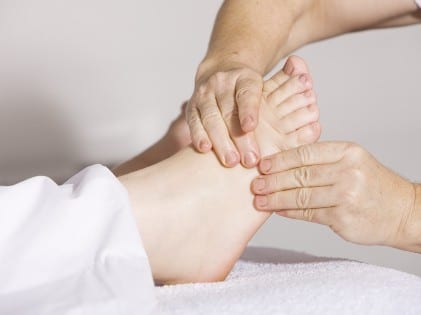Often sciatica is confused with ‘non-specific back pain’. It is actually a symptom of excruciating nerve pain that can range anywhere from mild to moderate, and even severe in extreme cases. Actually, sciatica is the result of a compressed nerve in the lower spine. The nerve that leads to sciatica can impede the ability of the suffering person to function normally. Hence, it makes sense to research options that would help relieve pain. Check out these tips that can reduce sciatic pain to a considerable extent.
Incorporate Massage And Avoid Pain Killers
 Massages contribute to relaxation, improved blood circulation, release of endorphins (the body’s natural hormones to decrease pain), and calming of the core spinal muscles. Different massaging techniques can have different benefits. For instance, the myofascial release through Shiatsu (a Japanese massage technique using fingers and the pressure of the palms along with stretching techniques), improved flexibility through deep tissue massage, and dealing with knots and muscle tension through manual therapy (medical massage). Instead of popping pills now and then, it’s better to choose from these massages. They are helpful to not only relieve sciatica pain, but also useful for muscle strain, fatigued musculature in the lower spine, and poor posture.
Massages contribute to relaxation, improved blood circulation, release of endorphins (the body’s natural hormones to decrease pain), and calming of the core spinal muscles. Different massaging techniques can have different benefits. For instance, the myofascial release through Shiatsu (a Japanese massage technique using fingers and the pressure of the palms along with stretching techniques), improved flexibility through deep tissue massage, and dealing with knots and muscle tension through manual therapy (medical massage). Instead of popping pills now and then, it’s better to choose from these massages. They are helpful to not only relieve sciatica pain, but also useful for muscle strain, fatigued musculature in the lower spine, and poor posture.
Choose Nutritious Food Over Everything Else
Diets that are replete with nutritious foods, like fruits, vegetables, whole grain foods, can help reduce inflammation. You can also include green tea, black tea, ginger, and curcumin (turmeric) in your food as they are strong sources of anti-inflammatory substances that build immunity and benefit the overall health. If you opt for such diets, the likelihood of sciatica is decreased. In addition to improved dietary habits, you must try to avoid some practices as well. For starters, if you are a smoker, try to limit it. You must also try to avoid sugars, trans fats, refined carbohydrates, and hydrogenated oils – food that are known to induce inflammation. Try and check with your doctor before you make any radical dietary changes, especially if you consume medications and diet interference can result in potent issues.
Build On Micronutrients
 Supplements can help build micronutrients in the body that are often not obtained via regular diets. Such micronutrients include vitamins (D, E, B12, B6), zinc, magnesium, selenium, Fish oil (omega-3 fatty acids) – all of which can suppress the inflammatory mediators and resulting processes. For example, vitamin B benefits nerve health and reduces sciatica. Zinc, selenium, and curcumin (turmeric) supplements act as antioxidants in the body.
Supplements can help build micronutrients in the body that are often not obtained via regular diets. Such micronutrients include vitamins (D, E, B12, B6), zinc, magnesium, selenium, Fish oil (omega-3 fatty acids) – all of which can suppress the inflammatory mediators and resulting processes. For example, vitamin B benefits nerve health and reduces sciatica. Zinc, selenium, and curcumin (turmeric) supplements act as antioxidants in the body.
Opt For Mind-Body Techniques
Rely on the power of your mind to lessen the perception of pain caused by sciatica. There are mind-body techniques, like meditation, deep breathing exercises, guided imagery techniques, and cognitive-behavioral therapies, to relax your muscles and increase tolerance of pain. These techniques also reduce depression and anxiety – problems often associated with chronic pain.
Try Walking Inside A Swimming Pool
 Strange as it may sound, but water therapy can do wonders for sciatica. Try walking in waist-deep water for better nerve and muscle functioning in the lower body. Hydrostatic pressure, thermodynamics, hydrodynamic forces, natural buoyancy, and viscosity of water are chief aspects that result in the regulation of nerves and muscles in the body. As a result, you can exercise better, and that too with lesser pain.
Strange as it may sound, but water therapy can do wonders for sciatica. Try walking in waist-deep water for better nerve and muscle functioning in the lower body. Hydrostatic pressure, thermodynamics, hydrodynamic forces, natural buoyancy, and viscosity of water are chief aspects that result in the regulation of nerves and muscles in the body. As a result, you can exercise better, and that too with lesser pain.
Restorative Sleep Is Important
When it comes to sleep, both the quality and quantity of it can cause immense effects on the resulting pain and inflammation inside the body. While you are sleeping, a lot of inflammatory substances rise in the bloodstream and stay active through the night. If the sleep quality is poor, then these inflammatory agents keep circulating in the body the day as well that causes pain and fatigue. Hence, catching up on deep and restorative sleep is important to reduce inflammatory pain, and it also makes you feel refreshed and rejuvenated.
In case the sciatica pain worsens and affects your daily life patterns, it’s mandatory to check with your medical practitioner to get better ideas of pain relief options. Whether it’s a manual checkup, medications, or epidural steroid injections – your doctor can help you to make the best choice. Experts say that 40% of the people are likely to experience sciatica at some point in their lives, but there’s nothing to worry about, as long as you take the right steps and follow your doctor’s advice.
